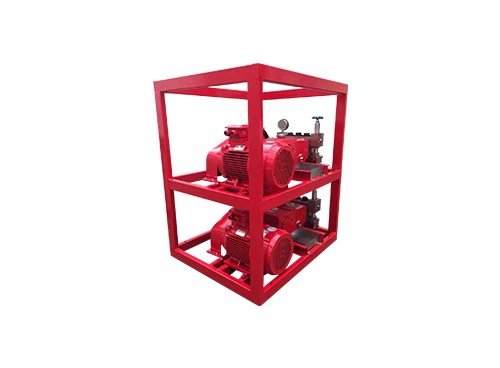Appearance and installation inspection
1. Clean the outer shell: Regularly clean the dust, oil and debris on the outer shell of the pump body to keep the pump body clean and tidy to facilitate heat dissipation.
2. Check the installation parts: Check whether the pump's anchor bolts, coupling bolts and other connecting parts are loose. If they are loose, tighten them in time to prevent vibration and damage during operation. At the same time, check whether the foundation of the pump has cracks, sinking and other problems. If there are any abnormalities, they should be handled in time.
Lubrication system maintenance
1. Check the oil level: Regularly check the oil level of the bearing box and other parts to ensure that the oil level is within the normal scale range. Too low oil level will lead to poor lubrication and accelerate component wear; too high oil level may cause oil temperature rise, oil leakage and other problems.
2. Replace lubricating oil: Replace the lubricating oil regularly according to the requirements of the equipment manual. Under normal circumstances, the lubricating oil should be replaced after a new pump has run for 500 hours, and then replaced every 2000-3000 hours. When replacing, the old oil should be drained clean, the oil pool should be cleaned, and then an appropriate amount of new oil should be added. At the same time, pay attention to the brand and quality of the lubricating oil. Different types of pumps may require different lubricating oils.
Sealing system maintenance
1. Check the sealing condition: Observe whether there is leakage at the shaft seal of the pump. Minor leakage can be solved by adjusting the tightness of the sealing gland, but if the leakage is serious, the seals, such as mechanical seals, packing seals, etc., should be replaced in time.
2. Prevent damage to the sealing surface: In daily operation, avoid running the pump under harsh conditions such as dry running or cavitation to avoid damaging the sealing surface. At the same time, when disassembling and installing the parts of the pump, pay attention to protecting the sealing surface to prevent it from being scratched or bruised.
Electrical system maintenance
1. Check the electrical connection: Check whether the motor terminal is loose or hot, and whether the wire is damaged or aged. If there is any looseness, tighten it in time, and the damaged or aged wires should be replaced in time to prevent electrical failures.
2. Test insulation resistance: Use an insulation resistance tester to measure the insulation resistance of the motor regularly to ensure that its insulation performance is good. Generally, the insulation resistance of the motor is required to be no less than 0.5 megohms. If the insulation resistance is too low, the cause should be found and dried or repaired.
3. Check the control equipment: Check the control cabinet of the Fire-fighting Pump to see whether the instrument display is normal, whether the operation of buttons and switches is flexible and reliable, and whether the electrical components such as relays and contactors are damaged or overheated. If there is a problem, the relevant components should be repaired or replaced in time.
Performance test and maintenance
1. Pressure and flow inspection: Start the Fire-fighting Pump regularly to check whether the outlet pressure and flow of the pump meet the specified values. The pressure gauge and flow meter installed on the pipeline can be used to read. If the pressure or flow is abnormal, the cause should be analyzed. It may be caused by pipeline blockage, impeller wear, valve failure, etc., and specific problems should be investigated and repaired.
2. Trial operation: Perform a trial operation once a week or month, and let the pump run for a period of time under no-load or light-load conditions to check the overall performance and operation of the pump. The trial run time is generally 10-15 minutes. During the trial run, closely observe whether the sound, vibration, temperature, etc. of the pump are normal. If there is any abnormality, stop the machine immediately for inspection.
Maintenance of auxiliary equipment
1. Check the valve: Check the valves on the inlet and outlet pipes of the Fire-fighting Pump, including gate valves, butterfly valves, check valves, etc., to ensure that the valves are flexible, well sealed, and leak-free. Lubricate the transmission parts of the valve regularly to prevent rust and jamming.
2. Clean the filter: The filter installed on the suction pipe should be cleaned regularly to prevent impurities and foreign matter from entering the pump body and affecting the normal operation of the pump. Generally, every quarter or according to actual conditions, when the pressure difference before and after the filter increases significantly, the filter should be disassembled for cleaning to remove the dirt and debris inside.

